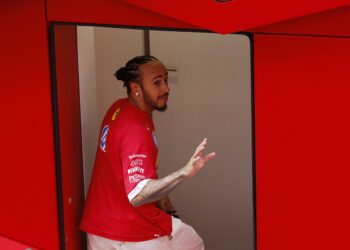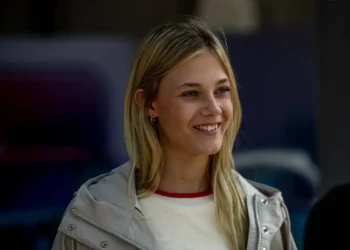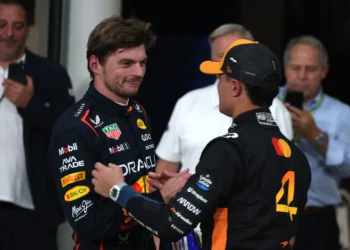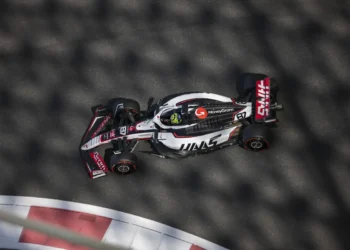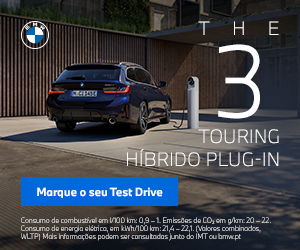In NASCAR, winning races isn’t enough—you need big-money sponsorships to stay on top. No one knows this better than Denny Hamlin, who, despite being one of the sport’s biggest names, is heading into the 2025 season without a full-time primary sponsor for the first time in his career.
Meanwhile, IndyCar legend Helio Castroneves is waltzing into NASCAR’s biggest race with a $3 billion sponsor in his corner—without even having to fight for his spot.
🚨 Does the Open Exemption Provisional (OEP) rule create an unfair advantage for outsiders? Is NASCAR’s sponsorship market in trouble? Let’s break it all down.
Castroneves Gets a Free Pass to the Daytona 500—With Major Sponsorship
Helio Castroneves is a four-time Indianapolis 500 champion, but in NASCAR, he’s a rookie. Yet, thanks to NASCAR’s Open Exemption Provisional (OEP) rule, the 50-year-old Brazilian doesn’t have to qualify for the Daytona 500—he’s already in.
And to make things even more controversial? He’s landed a massive sponsorship deal with Wendy’s, a company worth $3 billion and trading at $14.49 per share.
The irony isn’t lost on Hamlin.
“It just doesn’t sit right,” Hamlin said.
“With all due respect to Helio, he hasn’t paid his dues in NASCAR, and yet he gets a free pass into the biggest race of the year?”
For Castroneves, the OEP rule is a golden ticket—giving crossover stars a marketing boost and automatic entry into NASCAR’s biggest events. But for full-time Cup drivers like Hamlin, it’s another example of how the business of NASCAR is shifting—and not in their favor.
Denny Hamlin: A NASCAR Icon With No Full-Time Sponsor?
Hamlin, a three-time Daytona 500 winner and one of NASCAR’s most successful drivers, has hit a financial brick wall.
After 20 years of unwavering support, FedEx pulled the plug on its primary sponsorship of Hamlin’s No. 11 car after the 2024 season.
🚨 Who’s still backing Hamlin?
- Coca-Cola and Sport Clips remain involved.
- King’s Hawaiian will sponsor a few races, but not the full season.
But it’s a far cry from the days when one major brand would fund an entire Cup Series season.
“In our sport, sponsorship dollars aren’t flowing like they used to,” Hamlin admitted.
“Teams are having to work harder than ever to get money, and it’s not as simple as being a good driver.”
For Hamlin, the contrast with Castroneves is frustrating—a crossover star gets instant sponsorship, while a longtime NASCAR veteran fights to keep his car funded.
NASCAR’s Sponsorship Market: A Broken System?
NASCAR has seen sponsorship models change drastically over the years:
🔹 2000s & Early 2010s: Full-season sponsorships from one major brand (e.g., Lowe’s for Jimmie Johnson, Home Depot for Tony Stewart).
🔹 2020s: Sponsors are spread across multiple races to reduce financial risk.
🚨 The result? Even top drivers like Hamlin struggle to secure consistent financial backing.
And while NASCAR is trying to grow its audience with the OEP rule, it raises an important question:
➡️ Should crossover stars get an automatic pass into NASCAR’s biggest races when full-time drivers struggle to keep their seats?
Final Verdict: NASCAR’s Business Model Is Changing—But Is It Fair?
🔹 Helio Castroneves lands a massive sponsor (Wendy’s) and a free Daytona 500 entry.
🔹 Denny Hamlin—one of NASCAR’s biggest names—is scrambling for financial backing.
🔹 The Open Exemption Provisional (OEP) rule creates controversy—should non-NASCAR veterans get a free pass?
This isn’t just about Helio vs. Hamlin—it’s about how NASCAR’s sponsorship model is evolving.
➡️ Is NASCAR prioritizing crossover appeal over long-term loyalty to its full-time drivers?
➡️ Will veterans like Hamlin be forced to downsize or retire if sponsorship dollars keep drying up?
➡️ Or is this just the new reality in motorsports—where marketing potential outweighs racing credentials?
One thing is clear: in NASCAR, nothing is guaranteed—not even for the sport’s biggest stars.


